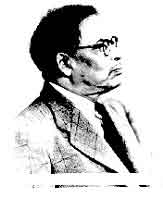|
|
Hello, I am Meghnad N. Saha, an Indian physicist and astronomer. In the 1920's and 30's, I worked with Henry Russell, B. Stromgren, and Subrahmanyan Chandrasekhar to help determine the chemical composition of stars. We found that hydrogen is by far the dominant constituent of stars. Helium was the next most important element, and carbon, nitrogen, oxygen, and iron were present in minor amounts. All other elements were present in trace amounts.
I would like you to help me determine the elements in some stars and also in the space between them! How do we do that? Again, the answer is: by studying spectra. You are now familiar with the spectra of many different stars. The peaks and valleys in a star's spectrum carry the signatures of certain elements in various states of ionization. Elements emit light at a few discrete frequencies, and this makes peaks in the spectrum called emission lines .
Sometimes a star's light will pass through a cloud of cooler gas on its way toward a telescope. When this happens, the elements in the gas cloud also leave their fingerprint on the star's spectrum, by absorbing the star's light at their signature frequencies. This creates absorption lines which appear as valleys in the spectrum. You might not think so at first, but this is really very common. Sometimes the cloud is actually the gaseous outer layer of the star itself! You many want to print this handout on Stellar Atmospheres.
You know that each star's spectrum is a unique "fingerprint" for that star. Since the spectrum of each element and ionization state is unique, these peaks and valleys work like fingerprints for the elements in the star, or in the gas its light passes through. So from a star's spectrum we can identify what the star is made of, plus the location and composition of interstellar gas clouds.
Now go on to the next page, and we'll get a bit more specific.



